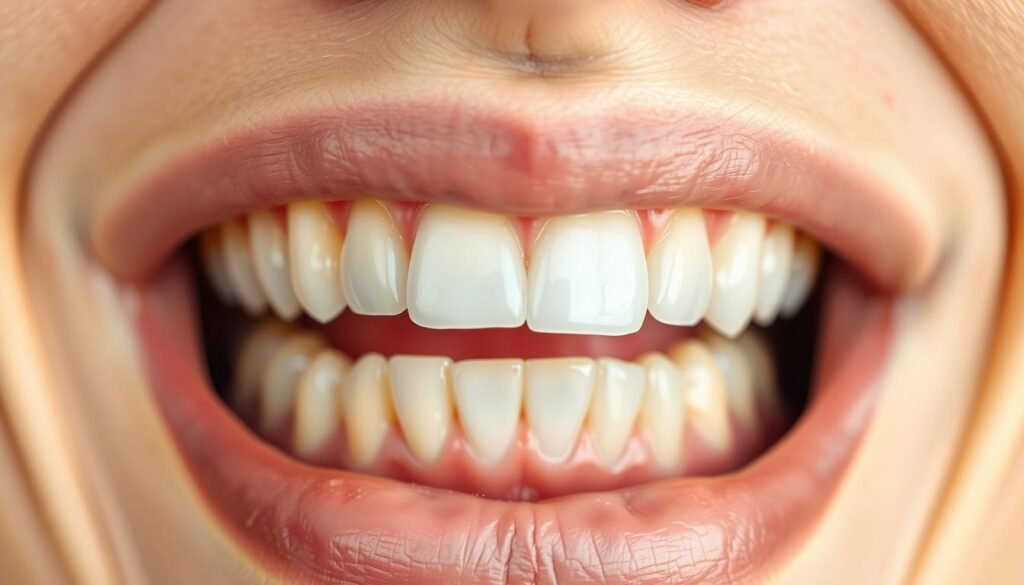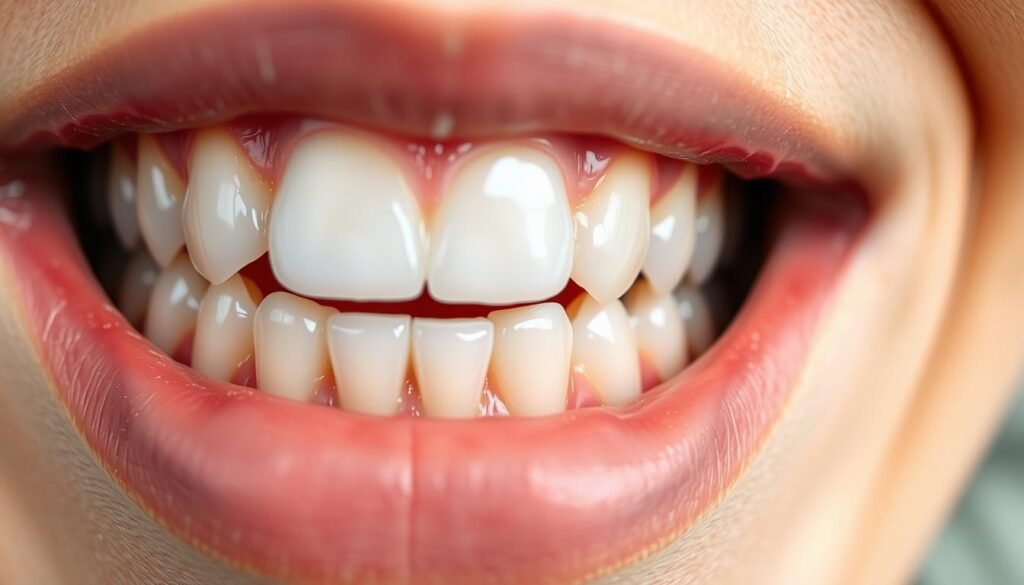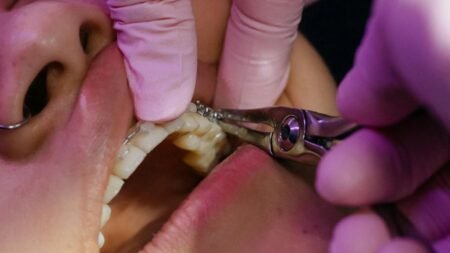Have you ever seen your gums look pale around your teeth and wondered why? This discoloration can be puzzling and worrying. It might show up suddenly, making you question its meaning and health effects.
White gums around teeth can mean many things, from harmless to serious health issues. It’s important to know the causes and when to get professional help to keep your mouth healthy.
Surprisingly, white gums after brushing don’t always mean there’s a problem. It could be from brushing too hard or being sensitive to some toothpaste ingredients. But if the gums stay white, it’s time to check it out more closely.
There are many reasons for white gums, like anemia, poor nutrition, oral hygiene problems, or even serious conditions like leukoplakia. This article will cover the different causes, signs, and treatments for white gums. It also stresses the need for a dentist’s check-up and good oral care.
Understanding White Gums: An Overview
Seeing white gums around teeth can worry parents of toddlers and children. This often means there are health issues that need attention. Let’s look into what white gums are, their symptoms, and why keeping gums healthy is important.
What are white gums?
White gums mean the gums around teeth have changed color. They look white or swollen, unlike the usual pink. In kids, white gums can show many health problems, from small issues to big concerns.
Common symptoms associated with white gums
White gums often have other signs that point to oral health problems:
- Pain or discomfort
- Bleeding gums
- Bad breath
- Loose teeth
- Canker sores causing localized white spots
The importance of healthy gum color
Healthy gums are key for good oral health. They should look pink, showing they’re getting enough blood flow and are healthy. White gums in kids can mean different health issues.
| Condition | Description | Prevalence |
|---|---|---|
| Gingivitis | Initial stage of gum disease | Affects about 50% of American adults |
| Anemia | Causes pale gums due to iron deficiency | Common in children and toddlers |
| Oral thrush | Fungal infection causing white patches | More frequent in infants and young children |
| Leukoplakia | Thick white patches on gums | Rare in children, associated with tobacco use |
Seeing a dentist twice a year is key to avoiding white gums and keeping kids’ mouths healthy. Catching problems early can stop bigger issues like periodontitis and tooth loss.
White Gums Around Teeth: Causes and Contributing Factors
White gums around teeth can come from many things. Knowing what causes it is key to treating and preventing it. Let’s look at the main reasons behind this condition.
Anemia and Nutritional Deficiencies
Anemia often leads to white gums. It happens when you lack iron or vitamin B12, which affects oxygen delivery. Not having enough vitamin C and K can also hurt gum health, causing white spots.
Oral Hygiene Issues and Gingivitis
Bad oral hygiene is the main cause of gingivitis. This leads to plaque on teeth and gums, causing white patches and gum shrinkage. To avoid this, brush your teeth daily, floss, and use mouthwash.
Leukoplakia and Tobacco Use
Leukoplakia shows up as thick white or grey patches on the gums. It’s often linked to tobacco use, tooth damage, and dental devices. These patches can be sensitive to touch or certain foods.
Candidiasis (Oral Thrush)
Oral thrush is caused by too much Candida fungus and shows as white spots on the gums. People with weak immune systems, like those with HIV/AIDS or diabetes, are more likely to get it.
Other Medical Conditions Affecting Gum Color
Other things can make gums turn white:
- Oral lichen planus (autoimmune disease)
- Hormonal changes during pregnancy or menopause
- Canker sores
- Gum recession
- Oral cancer (in rare cases)
After teeth whitening, white gums can happen temporarily because of the chemicals used. If it doesn’t go away, see a dentist for help.
| Cause | Symptoms | Prevention/Treatment |
|---|---|---|
| Anemia | Pale gums | Iron-rich diet, supplements |
| Poor Oral Hygiene | White patches, plaque buildup | Regular brushing, flossing, dental cleanings |
| Leukoplakia | Thick white/grey patches | Quit tobacco, remove irritants |
| Oral Thrush | White spots, soreness | Antifungal medication, improved hygiene |

Diagnosis and Professional Assessment
If you see white gums around your teeth with braces, getting a professional check-up is key. Dentists are experts at finding out why this happens. They use different methods to check your mouth and figure out what to do next.
At your dentist visit, they’ll look at your mouth closely. They’ll check for gum disease signs like swelling, redness, or bleeding. They’ll focus on areas around your braces, where plaque often builds up.
The dentist will use a gum probe to check how deep the pockets are between your gums and teeth. Healthy gums have pockets no deeper than 3mm. If the pockets are 4mm or deeper, it could mean gum disease is affecting your jawbone.
| Probing Depth | Indication |
|---|---|
| Up to 3mm | Healthy gums |
| 4mm and above | Potential gum disease |
Sometimes, x-rays are needed to see deeper into your mouth and check for bone loss. For serious cases, panoramic x-rays give a full view of your jawbone and teeth.
Only a dentist or dental hygienist can properly clean away tartar buildup. Regular dentist visits are crucial, especially with braces, to keep your mouth healthy and avoid problems.
Treatment Options for White Gums
White gums can signal several oral health problems. The treatment depends on the root cause. Let’s look at ways to tackle white gums after wisdom teeth removal and other issues.
Medical Interventions and Prescriptions
Your doctor might suggest medicines for white gums. For anemia, iron supplements can be prescribed. Antifungal drugs are used for oral thrush. Corticosteroids may be given to those with oral lichen planus to ease symptoms.
Dental Procedures and Professional Cleanings
Regular dental cleanings are key for gum health. If you have gingivitis or periodontitis, scaling and root planing might be advised. These treatments remove plaque and tartar below the gum line, promoting gum health.
Lifestyle Changes and Home Remedies
Improving your oral hygiene is vital. Brush your teeth twice a day and floss often. Quitting tobacco use can greatly benefit your gum health. For quick relief, try saltwater rinses. Eating a diet full of vitamins and minerals also supports your oral health.
Addressing Underlying Health Conditions
White gums after wisdom teeth removal usually clear up with proper care. Always follow your dentist’s advice to avoid issues. For other conditions, work with your healthcare provider to create a detailed treatment plan.
| Condition | Treatment Approach |
|---|---|
| Anemia | Iron supplements, dietary changes |
| Gingivitis | Professional cleaning, improved oral hygiene |
| Oral thrush | Antifungal medications |
| Post-wisdom teeth removal | Proper aftercare, saltwater rinses |
Conclusion
White gums around teeth can mean different health issues or medical conditions. It’s important to know what white gums mean for early treatment. Various causes like anemia or leukoplakia need a doctor’s check-up.
Good oral hygiene helps prevent white gums. Brushing, flossing, and regular dental visits can lower your risk. If you see white gums often, see a dentist right away. Early action can stop bigger problems and keep your mouth healthy.
What you do in your daily life also matters. Stay away from tobacco, drink less alcohol, and eat well. This helps keep your gums strong. By watching your oral health and acting fast on any issues, you can keep your smile bright and your gums healthy for a long time.
FAQ – White Gums
What are the common symptoms associated with white gums?
White gums often show signs like pain, bleeding, loose teeth, and mouth ulcers.
What causes white gums around teeth in children or toddlers?
Poor brushing habits, not getting enough nutrients, or certain health issues can make gums white in kids and toddlers.
Can anemia lead to white gums around teeth?
Yes, anemia from iron or vitamin B-12 lack can make gums look pale or white.
Is it normal for gums to appear white after teeth whitening procedures?
After teeth whitening, gums might look a bit white or off-color at first. This should go away soon. If it doesn’t, see a dentist.
How important is it to maintain good oral hygiene for individuals with braces?
Keeping your mouth clean and seeing the dentist regularly is key if you have braces. Brushing, flossing, and dental cleanings help avoid problems like gingivitis and white gums.
What should be done if white gums persist after wisdom teeth removal?
If your gums stay white after removing wisdom teeth, follow your dentist’s aftercare advice closely. If it keeps up, it could mean an infection, so see a professional right away.








